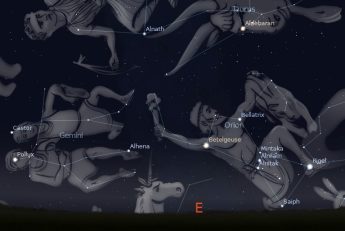This Week’s Sky at a Glance, 2024 Nov 9 – Nov 16
This Week’s Sky at a Glance, 2024 Nov 9 – Nov 16
Orion can be seen getting out of bed around 8 pm now, preparing for a night of hunting. Being a giant and very old, it takes an hour and a half for his hourglass shape to clear the horizon. He rises on his side and stands upright when he is in the south. The celestial equator, an imaginary line in the sky directly above our equator, runs very near Mintaka, the star at the right of Orion’s Belt. Therefore, Mintaka rises due east. Notice how huge Orion appears as he rises, bigger than he appears a few hours later in the southeast. This is the same optical illusion that makes the Moon appear larger when it is rising or setting. The twins Castor and Pollux of the constellation Gemini rise on their side at the same time as Orion, just to his left.
If you are into genealogy, Orion, as a son of Poseidon, was a cousin to Pollux, a son of Zeus. Castor had the same mother as Pollux but a mortal father, King Tyndareus of Sparta. Even stranger, Perseus was the great-grandfather of his half-brother Heracles (Hercules to the Romans); thanks, twice again, to randy old Zeus. Genealogy is more complicated when immortals are involved.
This Week in the Solar System
Saturday’s sunrise in Moncton is at 7:12 and sunset will occur at 4:53, giving 9 hours, 41 minutes of daylight (7:15 and 5:00 in Saint John). Next Saturday the Sun will rise at 7:22 and set at 4:45, giving 9 hours, 23 minutes of daylight (7:24 and 4:53 in Saint John).
The Moon is at first quarter on Saturday and it is full next Friday near the Pleiades star cluster. On Sunday it passes below Saturn, and telescope users might see it occult Neptune a little before 10:30 pm Tuesday. The farthest planet reappears from behind the Moon just over an hour later. Mercury is low in the southwest this weekend, setting 50 minutes after sunset and extending that to an hour next weekend when it reaches its greatest elongation from the Sun. Bright Venus slowly gains altitude as it continues to more eastward from the Sun, setting around 7 pm. On Wednesday a telescope can reveal Jupiter’s moon Ganymede disappear behind the planet just before 7 pm and reappear two hours later, then catch its Red Spot around 10 pm. Now within the constellation Cancer the Crab, Mars moves to within a wide binocular view of the Beehive star cluster next weekend. We could see some extra shooting stars this week from the South and North Taurid meteor showers.
The Fredericton Astronomy Club meets this Tuesday at 7 pm in the UNB Forestry/Earth Sciences building. Tune in to the Sunday Night Astronomy Show at 8 pm on the YouTube channel and Facebook page of Astronomy by the Bay.

